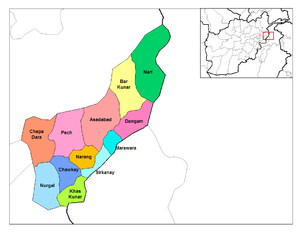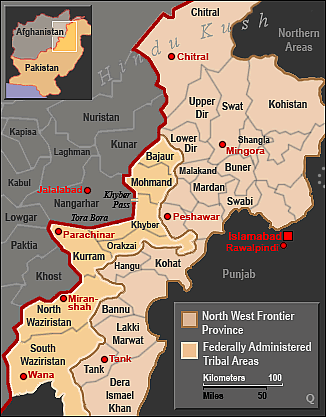Radio Azadi reports that from early Sunday morning in the Marawara District of Kunar Province, a vigorous firefight has been pursued by the Taliban on the one hand and on the other, joint NATO and Afghanistan National Army troops. At least three NATO troops were killed, including 2 Americans, in the fighting.
Those tribesmen who take up arms against NATO and the central government are termed ‘Taliban’ in the Western press. But the major Muslim fundamentalist guerrilla group in Kunar Province is the Hizb-i Islami of old-time Reagan-era ‘freedom fighter’ Gulbuddin Hikmatyar. Hikmatyar has been talking about negotiating a peace with Karzai. In March, his forces fought a battle with rival Taliban that left dozens dead. Hikmatyar offers himself as a mediator with the militants who can pave a path to peace and reconciliation if only the US and NATO will agree to get out of his country.
Just Saturday, a battle broke out between Taliban and Hizb-i Islami militants in Maidan Wardak province, southwest of Kunar, on the other side of Kabul.
Not only is President Hamid Karzai reputedly talking to Hikmatyar, but Aljazeera reported Sunday that he has had secret meetings with Siraj Haqqani. The son of old-time Reagan-era Mujahidin leader Jalaluddin Haqqani, Siraj is based in North Waziristan and raids into Afghanistan. Western intelligence considers the Haqqani network closest to the Arab al-Qaeda cells in Pakistan’s tribal belt. If it is true that Karzai is talking to Haqqani (he denies it), this step is taken to signal that he may be tacking toward Pakistan and its Inter-Services Intelligence, and away from the embrace of the United States.
On ABC This Week with Jake Tapper, CIA director Leon Panetta threw cold water all over the idea of talks and reconciliation:
‘ the bottom line is that we really have not seen any firm intelligence that there’s a real interest among the Taliban, the militant allies of Al Qaida, Al Qaida itself, the Haqqanis, TTP, other militant groups. We have seen no evidence that they are truly interested in reconciliation, where they would surrender their arms, where they would denounce Al Qaida, where they would really try to become part of that society.’
I think Panetta is being too categorical in his skepticism. There are other reasons for tribal factions to dicker with bigger, stronger forces than fear of annihilation (indeed, given Pashtun codes of honor, they could hardly parley when their situation was truly perilous). For instance, there is Hikmatyar’s feud with the Taliban, which may have brought him closer to compromise with Karzai.
As if to underline Panetta’s skepticism, however, the Taliban leader in Kunar Province, Obaid al-Rahman, had said this weekend that he and other Taliban were delighted with the firing of Gen. Stanley McChrystal, since it would take his successor, Gen. David Petraeus, time to get used to Taliban tactics. In the meantime they could regroup. He promised a dramatic attack soon. Obaid al-Rahman also offered Gen. Petraeus a praetorian “Guard of Death.” It is therefore no surprise that fighting broke out in Marawara between US/NATO forces and the Taliban.

In the US, Afghanistan is mostly discussed abstractly, leading to categorical judgments like that of Panetta. But let us look at the concrete situation. Marawara in southeast Afghanistan, abutting Pakistan’s Bajaur Tribal Agency, is just about at the end of the world. Here are its social statistics [pdf]. It is 86 percent either mountainous or semi-mountainous. Its 400,000 people are 96 percent rural. It still has thousands of pastoral nomads. The people of Marawara widely lack access to clean drinking water or sanitary toilets. Some 47% of the men are literate (a remarkably high number, probably attesting to the efficacy of Qur’an schools) but only 18% of women are. The majority is Pashtuns, but it has a small Nuristani minority. Nuristanis, called ‘Kafirs’ until their conversion to Islam in 1896, speak an Indo-Iranian language very different from Persian or Punjabi, which is often considered a third branch of this language family, and likely they are descendants of a very ancient wave of Indo-European migration into Central Asia that never went south into India. The major tribes of Marawara, mostly Pashtuns, include the Safi, Salarzai, Mashwani, Mamon, and Shinwari.

Districts such as Marawara are in the midst of an internal fight. Some of the villages and the few urban people support the government of Hamid Karzai and his NATO allies. A provincial reconstruction team visited the district in January and spoke of progress in building a district government center (where Afghanistan National Army troops would also be stationed) and in fighting malnutrition and malaria.
But many young tribesmen do not want the government center or the Kabul troops, or the foreign armies. Government programs do not help everyone equally. Perhaps they have even been disadvantaged by changes wrought from the outside. For them, independence and Muslim fundamentalism and local interests are supreme, and they will not rest until the foreign troops (and they may well count the disproportionately Tajik national army in that category) are out.
It is not clear from the vague Persian and English press reports whether Sunday’s battle was with Taliban, or Hizb-i Islami, or just tribal youth who don’t like foreigners. If NATO is fighting Taliban in Marawara, they may be making friends thereby with Hizb-i Islami, which had been in the past the second-largest insurgent group, responsible for significant losses of life among US and NATO soldiers.
Of course, that issue raises the question of which faction of Taliban is active in Marawara. Is it the Old Taliban of Mulla Omar (which tends to have its power bases in the West) or the Pakistani Taliban (Tehrik-i Taliban Pakistan), based over the border in Pakistan?
In any case, two American soldiers died fighting in Marawara on Sunday, along with another NATO soldier. The Western press just said it was in eastern Afghanistan. Maybe they mentioned Kunar. Not all did. We aren’t told the details of these things. Which tribesmen fought? Under whose banner, exactly? Is the fighting a cause of despair, as we’re losing troops at the end of the world? Or were they maneuvering Hikmatyar and Hizb-i-Islami into an alliance with Karzai that seems promising as a way of ending the war?
In other news, Taliban set a roadside bomb in the northern Faryab Province that killed 4 Norwegian troops on Sunday, as well. That datum is actually quite weird. Faryab is mostly Uzbek, with a Tajik minority, and Pashtuns there are only 12 percent of the population. But likely it was a cell of radicalized Pashtuns that carried out the bombing. Faryab is a relatively calm, safe, posting. It is a little worrying that the Taliban are developing such long arms that they can reach into it and hit NATO, way up there.
Marawara. Faryab. The words mean nothing to most Westerners, even as they insist that their security depends on what happens in those fabulous and distant places. But if we do not even know what the fighting is about in those places, we do not understand the circumstances in which young men of NATO gave their lives Monday. And since in a democracy, young men fight on behalf of we the people, we have an obligation to know more about the hells into which we send them before we conclude that we did the right thing.



 © 2026 All Rights Reserved
© 2026 All Rights Reserved